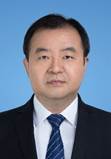Report Abstract
New Generation Photonic Networks from Micro-scale Interconnection to Satellite Communications
Jie Zhang
State Key Lab of Information Photonics and Optical Communications, Beijing Univ. of Posts and Telecommunications, Beijing, 100876, China
lgr24@bupt.edu.cn
Abstract
After more than 50 years of development, optical fiber communication networks have become the most important information infrastructure around the world, featuring large capacity, high speed, and high reliability. As the capacity continues to grow, intelligence has become the growth point of its advancing quality and efficiency. Artificial intelligence and digital twins have gradually created a new ecosystem of services for photonic networks. However, with the gradual expansion of the human activities, communication requirements have extended to the connection between the chips in microcosmic and to the connection with the space in macroscopic. Laser has become one of the most important forms of space communication. This report reviews the development history of optical fiber communication networks in the past 50 years, and expounds the new generation technology of intelligent controlling in photonic networks. Then we focus on the future trends and challenges of development from micro-scale photonic networks to satellite communications.
 Prof. Jie Zhang received the B.S. degree in communication engineering and Ph.D. degree in electromagnetic field and microwave technology from Beijing University of Posts and Telecommunications (BUPT), respectively in 1993 and in 1998. He is currently the Executive Dean of School of Electronic Engineering and Vice Director of State Key Lab of Information Photonics and Optical Communications at BUPT. He has published more than 300 technical papers, authored 15 books or book chapters and served as TPC chair of ACP 2020. His research focuses on optical network architecture, protocols and standards.
Prof. Jie Zhang received the B.S. degree in communication engineering and Ph.D. degree in electromagnetic field and microwave technology from Beijing University of Posts and Telecommunications (BUPT), respectively in 1993 and in 1998. He is currently the Executive Dean of School of Electronic Engineering and Vice Director of State Key Lab of Information Photonics and Optical Communications at BUPT. He has published more than 300 technical papers, authored 15 books or book chapters and served as TPC chair of ACP 2020. His research focuses on optical network architecture, protocols and standards.
Combined Four-Dimensional C4-256 Modulation and Nonbinary KP4 FEC for Short-Reach Coherent Transmission
Yi Cai
Soochow University, 1 Shizi Street, Suzhou, Jiangsu, 215006, China
Tel: +86-18625008651, <yicai@ieee.org>
Abstract
In this paper, we investigate the performance of combining a 4-dimensional modulation format with non-binary FEC in coherent optical transmission systems. We demonstrate with both simulations and experiments that the employment of non-binary FEC fully exploits the advantage of the 4-dimensional modulation format, which can outperform its PM-16QAM counterpart by abut 0.7-dB of required OSNR in short-reach applications.
 BIOGRAPHY, Prof. Yi Cai received the B.S. degree in optical engineering from Beijing Institute of Technology, Beijing, China, in 1992, the M.S. degree in electrical engineering from Shanghai Institute of Technical Physics, Chinese Academy of Sciences, Shanghai, China, in 1998, and the Ph.D. degree in electrical engineering from the University of Maryland Baltimore County, Baltimore, in 2001.
BIOGRAPHY, Prof. Yi Cai received the B.S. degree in optical engineering from Beijing Institute of Technology, Beijing, China, in 1992, the M.S. degree in electrical engineering from Shanghai Institute of Technical Physics, Chinese Academy of Sciences, Shanghai, China, in 1998, and the Ph.D. degree in electrical engineering from the University of Maryland Baltimore County, Baltimore, in 2001.
He joined the forward-looking research group at Tyco Telecommunications (now TE SubCom) as a Senior Member of Technical Staff in 2001, and he was named a Distinguished Member of Technical Staff of TE SubCom in 2008. In 2011, he joined Huawei USA as a Director of the Optical Business Unit. In 2012, he joined ZTE TX as a Director of Digital Signal Processing. He is currently a Distinguished Professor at Soochow University. In over 20 years of career, he engaged in the research and development of several generations of optical fiber transmission systems, especially the applications of signal processing and forward error correction techniques. He holds 45 patents and over 100 technical publications in the area of optical fiber communications.
Dr. Cai is a Fellow of the Optical Society of America (Optica). He served as a technical program sub-committee chair for Optical Fiber Communication Conference (OFC) 2020. He also served on the technical program committees of OFC, Opto-Electronics and Communications Conference (OECC), Photonics West, and Asia Communications and Photonics Conference (ACP).
Multi-Access Coherent: Redefine the Coherent Optics in Next-Gen Access Network
Junwen Zhang
Fudan University, Shanghai, China, 200433
Tel: +86-21-3124608, Fax: same as Tel, <junwenzhang@fudan.edu.cn>
Abstract
Coherent optics has been proposed to be a promising candidate for future single-wavelength 100 Gb/s+ optical access networks. It has been a game changer in long-haul and metro networks enabling ultra-high-speed data transmission. Now coherent optics meet its prime time in short-reach access networks. Multi-access coherent optics has been redefined in the optical access networks, for example, coherent passive-optical-networks (Coherent PON). In this talk, I will provide a review of use cases, challenges and recent progresses of the high-speed coherent access for 100G/λ and beyond fiber access network. The technical insights into the key enabling technologies including coherent upstream burst detection, burst-mode DSP, and innovation efforts on cost reduction in Coherent PON will be introduced. Finally, the talk will discuss the outlook of coherent PON towards the rate flexible and adaptive fiber access network.
 BIOGRAPHY, Prof. Junwen Zhang received his Ph.D. degree from Fudan University in 2015. From 2015 to 2016, he studied and worked at Georgia Tech. Dr. Zhang joint ZTE(Tx) in 2016, working on Next-Gen high-speed optical access network. During 2018 to 2020 he worked on optical and wireless access in CableLabs. In 2021, he joint Fudan University, worked as a Full-time professor. His has published more than 200 papers on high-speed optical and wireless communication. He received Marconi Society Paul Baran Young Scholar Award in 2016, IEEE Photonics Society Graduate Student Fellowship and Wang Daheng Optics Award in 2013. He has been the TPC member of the OFC 2019-2021 in Optical Access Networks Technical Program Subcommittee (N4), and chairs N4 in OFC 2022.
BIOGRAPHY, Prof. Junwen Zhang received his Ph.D. degree from Fudan University in 2015. From 2015 to 2016, he studied and worked at Georgia Tech. Dr. Zhang joint ZTE(Tx) in 2016, working on Next-Gen high-speed optical access network. During 2018 to 2020 he worked on optical and wireless access in CableLabs. In 2021, he joint Fudan University, worked as a Full-time professor. His has published more than 200 papers on high-speed optical and wireless communication. He received Marconi Society Paul Baran Young Scholar Award in 2016, IEEE Photonics Society Graduate Student Fellowship and Wang Daheng Optics Award in 2013. He has been the TPC member of the OFC 2019-2021 in Optical Access Networks Technical Program Subcommittee (N4), and chairs N4 in OFC 2022.
High Speed Thin-film Lithium Niobate Devices
Xinlun Cai
State Key Laboratory of Optoelectronic Materials and Technologies and School of Electronics and Information Technology, Sun Yat-sen University, Guangzhou 510000, China
Caixlun5@mail.sysu.edu.cn
Abstract
Driven by 5G, IoT, virtual reality, artificial intelligence and other new generation information technologies, the wave of broadband has swept the world, information capacity has grown exponentially in the past decade, and the bandwidth and energy consumption of optical communication networks are under tremendous pressure. Electro-optical modulator is the core device to realize information photoelectric conversion, and it is also a key link to break through the two major technical challenges of bandwidth and energy consumption. The new electro-optical modulator chip with large bandwidth, low power consumption, low loss and miniaturization is a transformative technology to fully replace the traditional lithium niobate crystal devices, and is one of the core technologies that countries around the world are focusing on. This report mainly introduces several advances in lithium niobate thin film electro-optical modulators by the reporter and his team in recent years, including: 1) high performance lithium niobate thin film photonic integrated devices and chips; 2) silicon and lithium niobate heterogeneous integrated electro-optical modulators.
 BIOGRAPHY, Prof. Xinlun Cai received his undergraduate degree from Huazhong University of Science and Technology, and his Ph.D. degree from the Department of Electrical Engineering, Bristol University, U.K. He returned to China in 2014 and joined the School of Electronic Information Engineering, Sun Yat-sen University, where he received the National Natural Science Foundation of China's Outstanding Youth Fund in 2016 and the Ministry of Science and Technology as the project leader in 2019. In 2019, he was awarded the "Broadband Communication and New Network" key R&D project by the Ministry of Science and Technology. He has published more than 60 SCI papers in Science, Nat. Photonics Nat. Commun., Science Advances, Light: Sci. & Appl., Optica and other academic journals, and three articles have been selected as top 1% highly cited papers in ESI. He has made 15 oral presentations at OFC, ECOC and CLEO, two of which were accepted as Post-deadline papers, and one of which was rated as Top Score Paper of OFC 2020, and the results of silicon and lithium niobate heterogeneous integrated modulator were selected as one of the "Top Ten Advances in Optics in China 2019 ".
BIOGRAPHY, Prof. Xinlun Cai received his undergraduate degree from Huazhong University of Science and Technology, and his Ph.D. degree from the Department of Electrical Engineering, Bristol University, U.K. He returned to China in 2014 and joined the School of Electronic Information Engineering, Sun Yat-sen University, where he received the National Natural Science Foundation of China's Outstanding Youth Fund in 2016 and the Ministry of Science and Technology as the project leader in 2019. In 2019, he was awarded the "Broadband Communication and New Network" key R&D project by the Ministry of Science and Technology. He has published more than 60 SCI papers in Science, Nat. Photonics Nat. Commun., Science Advances, Light: Sci. & Appl., Optica and other academic journals, and three articles have been selected as top 1% highly cited papers in ESI. He has made 15 oral presentations at OFC, ECOC and CLEO, two of which were accepted as Post-deadline papers, and one of which was rated as Top Score Paper of OFC 2020, and the results of silicon and lithium niobate heterogeneous integrated modulator were selected as one of the "Top Ten Advances in Optics in China 2019 ".
DSP-free RAU in Coherent RoF Mobile Fronthaul for B5G mm-wave communications
Lei Deng, Haiping Song, and Ming Tang
Wuhan National Laboratory for Optoelectronics and School of Optical and Electronic Information, Huazhong University of Science and Technology, Wuhan 430074, China
Tel: +86 27 8755 9189, Fax: +86 27 8755 6188, <denglei_hust@mail.hust.edu.cn>
Abstract
It is well-known that DSP-free is very helpful to design a remote antenna unit (RAU) with the advantages of low cost, low latency, and simple infrastructure. And millimeter-wave (mm-wave) communication has become an attractive technique in the fifth generation (5G)/B5G mobile communication systems. In this presentation, three schemes for the design of DSP-free mm-wave RAU are proposed. Scheme I: A coherent analog radio over fiber (A-RoF) scheme to realize the transmission and detection of four-independent mm-wave signals with the same carrier frequency on a single-wavelength is proposed. And a novel carrier polarization rotation module based on the self-polarization stabilization technique is proposed for the four-independent mm-wave signals detection enabled by a single polarized optical carrier. Scheme II: On the basis of scheme I, one MZM is introduced to generate two second-order optical subcarriers at BBU. And photonic up-conversion is realized for four-independent RF signals simultaneously enabled by self-heterodyne detection at RAU. Therefore, the sampling-rate and bandwidth requirement of the photonic and electronic components at the transmitter end could be greatly reduced. Scheme III: An asymmetric dual-single-sideband (SSB) modulation scheme for photonic co-frequency mm-wave signals generation and DSP-free receiver is proposed. And the crosstalk between symmetric sidebands is effectively avoided. Besides, the photonic frequency up-conversion is realized after PD detection.
 Prof. Lei Deng received the B.S., M.S., and Ph.D. degrees in Optoelectronics and Information Engineering from Huazhong University of Science and Technology, Wuhan, China, in 2006, 2008, and 2012, respectively. Now, he is a professor in the school of optical and electronic information from Huazhong University of Science and Technology. His research interests include fiber-optic communications, advanced modulation formats, and OFDM in radio-over-fiber (RoF) systems and next-generation passive optical network (PON) systems. He has leaded 3 National Natural Science Foundation of China projects and 2 National Key Research and Development Program of China, published more than 100 authored and co-authored papers award over 6 patents since 2016.
Prof. Lei Deng received the B.S., M.S., and Ph.D. degrees in Optoelectronics and Information Engineering from Huazhong University of Science and Technology, Wuhan, China, in 2006, 2008, and 2012, respectively. Now, he is a professor in the school of optical and electronic information from Huazhong University of Science and Technology. His research interests include fiber-optic communications, advanced modulation formats, and OFDM in radio-over-fiber (RoF) systems and next-generation passive optical network (PON) systems. He has leaded 3 National Natural Science Foundation of China projects and 2 National Key Research and Development Program of China, published more than 100 authored and co-authored papers award over 6 patents since 2016.